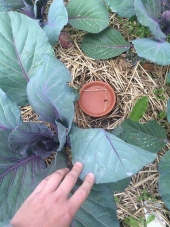We have a fairly large number of stump holes from pine
trees on our property. The holes can be over a foot ( 0.3 m) deep into very stiff red clay and have formed where the long tap
roots have rotted.. The clay doesn't slump and fill the holes. Filling with woodchips or organic matter is a temporary solution - the
wood and weeds are consumed by the community in the lively soil and eventually the hole is back (perhaps a little less deep). The previous owner left some kitty litter clay which has been successful in some of the smaller holes (places where the ground was graded over stumps that have now dissolved, and the "cap" of clay is subsiding in the void).
I am particularly interested in filling stump holes that are near where we need to walk. The holes are remarkably frequent and hazardous. At certain times of the year undergrowth or fallen leaves can hide them. While sometimes it's OK to make trails avoid them, other areas need a bit more latitude in movement.
Clay or rocks seem like the only solution, but i'd need to source them from somewhere else. Whenever i have a need to dig into the clay, i take the spoil to a hole and refill, but there are many more stump holes than my need to dig.
However, I have wondered about broken pottery and possibly even broken glass. Or even cans? It seems even with small voids, metal, ceramic, and glass waste could fill to the top six inches and then be capped with clay. I assume the voids might slowly fill with clay from the cap, and that the cap would need to be refreshed.
Barring catastrophic change, this area's planning has the lot size staying the same (or a little larger), and any agricultural use is not going to be at a large scale. Given proximity to septic field and the well and the house, it's hard to imagine any plowing. This could be a surprise if the house were torn down and the property subdivided. Yech.
I'm happy to hear other thoughts!
judith





 6
6






 4
4




 4
4




 6
6














 3
3




 1
1








